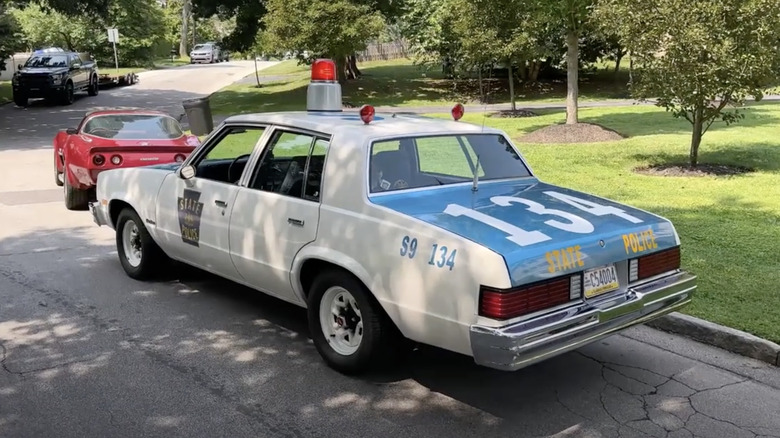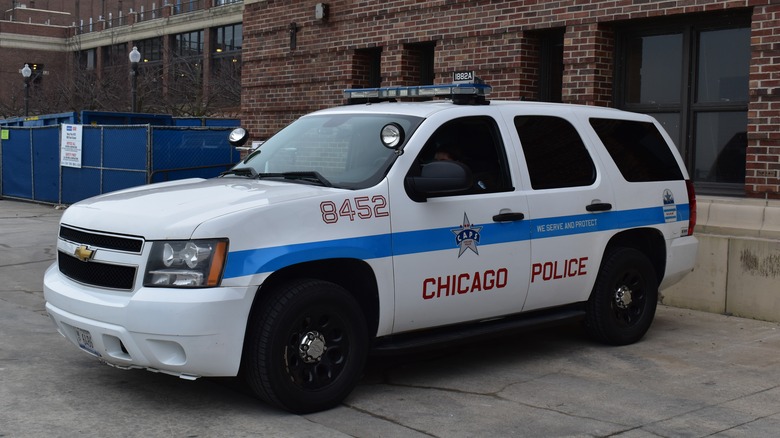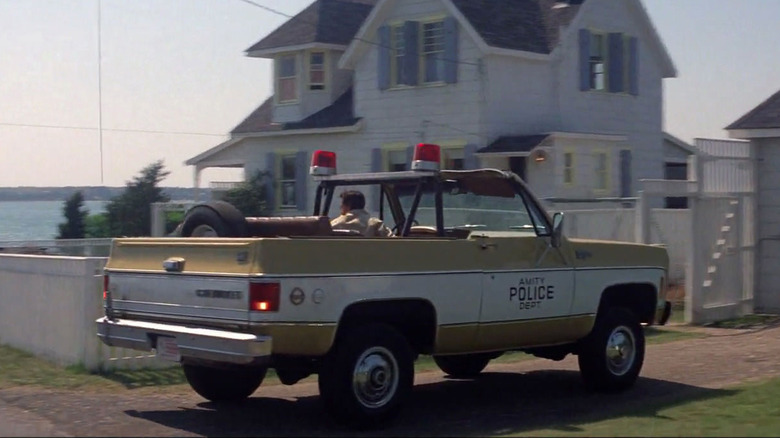5 Of The Most Iconic Chevrolet Cop Cars Ever Built
Chevrolet has been around since 1911 and has been a cornerstone of General Motors since 1918. In its century-plus of existence, Chevy has produced more than 200 million vehicles. Last year alone, Chevy sold more than 1.7 million units in the United States, placing it third behind Ford and Toyota (via Statista). Many of those sales were to taxi companies and law enforcement organizations, who need dependable vehicles that will last a long time. Domestic police forces also love the spaciousness of some of Chevy's models, which allows for transportation of arrestees and all the weapons and electronic equipment needed to do their jobs.
Most of us have at some point seen the Chevrolet bowtie logo get steadily bigger in our rearview mirror framed by flashing red and blue lights, but even the most law-abiding drivers have seen hundreds if not thousands of Chevy police vehicles from other, less stressful angles. Some of the five Chevrolets below are law enforcement icons for their widespread and persistent use, while others have been popular with fictional television and movie police forces.
The Caprice is one of the most recognizable cop cars around
The Caprice was one of the most successful Chevrolet models in history. This nameplate first appeared in 1965 as a high-end trim version of the Impala and became its own model the next year. It has lived on through six generations and is one of Chevrolet's best-selling full-sized models. The 1971-76 second generation Caprice was the largest Chevrolet sedan ever made, with a bumper-to bumper reach of more than 18.5 feet and a 121.5-inch wheelbase. It shrunk a bit in 1977 but still won Motor Trend Car of the Year, which it won again in 1991. Every year, the Michigan State Police tests various models for suitability as law enforcement vehicles, and the Caprice was at the top of their rankings from 1987 through 1996.
The 9C1 special equipment option got law enforcement buyers a full-perimeter frame, upgraded suspension and brakes, and a high-output alternator to run lights, sirens, and onboard electronics. These 9C1 Caprices got fuel injection in 1989, but soon after, many departments began converting their fleets from sedans to SUVs. The last Caprice left the factory in December 1996.
The Malibu was another common police cruiser
Chevy introduced the 9C1 version of the mid-sized Malibu in 1979 as a replacement for the discontinued Nova 9C1, and some police agencies opted for this more nimble and fuel-efficient model over the larger and heavier Impala and Caprice. The police-edition Malibu came as a coupe or sedan and had a full-perimeter frame like the Caprice 9C1. The Malibu 9C1 had several chassis upgrades over the civilian version, including heavy-duty springs, shocks, and body mounts. It was also outfitted with front and rear sway bars as well as police-edition wheels and tires. Thousands of 1979 9C1 Malibus went to police agencies in Chicago, Michigan, Ohio, and North Carolina.
Through 1983, engine options ranged from a 200-cubic-inch V6 that made less than 100 horsepower to gas and diesel versions of Chevy's ever-popular 350-inch V8 that produced 170 horsepower (gas) or 105 horses (diesel). In their testing of the 1983 Malibu 9C1 with a 305-inch V8, the Michigan State Police measured output at 145 horsepower and 240 pound-feet of torque, clocking a top speed of over 116 miles per hour. The Malibu badge went on the shelf from 1983 through 1997, and it went through additional updates in 2004, 2008, 2012, and 2016. The Malibu has reached the end of the line, though. In May, GM announced it was discontinuing the Chevy Malibu in November 2024.
The Secret Service uses Chevy Suburbans
The transition from sedans to SUVs didn't mean the end of Chevy's inclusion in law enforcement fleets. The rugged Suburban is now in its 12th generation, and its continuous production since 1935 makes it the longest-running nameplate in the world. The Secret Service has used armored Suburbans to transport and protect the President and Vice President for about 20 years, and the vehicles are flown around the world on C-17 and C-5 transport planes.
A specially-equipped Suburban known as the Roadrunner rides at the back of the Presidential motorcade to act as a mobile command and control vehicle (MC2V). It has several antennas mounted on the roof for voice communications, data, and even streaming video. Another Suburban with specialized gear usually rides between the President and Vice President's vehicles. This electronic countermeasures vehicle is there to protect the motorcade from improvised explosive devices (IEDs) and rocket-propelled grenades (RPGs).
Secret Service armored Suburbans are built by GM's Defense division and use a special body-on-frame design and suspension. Some body panels and drivetrain components are shared with civilian Suburban models, but GM Defense works with the State Department to design Suburbans for the Secret Service. In a 2021 statement announcing a new $36.4 million contract with the federal government, GM Defense president Steve duMont said, "Our development contract win speaks to our long-standing legacy of exceeding transportation capabilities and our new, HD Suburban will deliver government-specific advanced mobility solutions to meet the needs of DSS."
The Tahoe is another popular law enforcement SUV
While the Suburban is used widely by federal agencies like the Secret Service, the smaller, more agile Tahoe is a favorite of local and state police departments. General Motors makes two specialized Tahoe models for law enforcement agencies and other first responders like firefighters and paramedics. The Tahoe Police Pursuit Vehicle (PPV) and Special Service Vehicle (SSV) both have 125.9 cubic feet of cargo space and a 5.3-liter V8 that puts out 355 horsepower and 383 pound-feet of torque. They also share a 10-speed automatic transmission, 250-amp alternator, and 100-amp power supply in back.
The PPV can tow up to 6,000 pounds and the SSV can haul up to 8,200 pounds with the optional Max trailering package. Both models have integrated steering wheel controls for emergency equipment like lights and sirens. They also have hardware for a Wifi hotspot, and a rear view camera with an 8-inch dashboard display.
Both the Tahoe SSV and PPV have four light heads in the front grille and six more in the rear pillar, all of which can be configured in combinations of red, white, and blue. The Pennsylvania State Police and both the Arlington and Fort Worth, Texas police departments use Tahoe PPVs, which share a frame, body, engine, and transmission with civilian Tahoes. The tires, brakes, and suspension are upgraded, and the third row of seats is removed to make room for gun racks and computer equipment.
Chief Martin Brody drove a 1975 Blazer in Jaws
Although the Suburban and Tahoe are widely used by real-life law enforcement agencies, the most famous Chevy police SUV ever might be the 1973 K-5 Blazer that had a prominent role in the 1975 blockbuster "Jaws." The gold-and-white convertible Blazer is driven by Amity Island Police Chief Martin Brody (Roy Scheider) as he scurries around the island trying to warn residents and visitors about the danger lurking in the waters just offshore. This Blazer was introduced to four-wheel drive in 1973, which made it the perfect vehicle to traverse seamlessly across the dunes, beach, and island roads in the film.
The '70s-era Blazer's recognizable form made it very popular with Hollywood producers. It was also used as a law enforcement vehicle in dozens of productions, from television shows like "The Incredible Hulk, "Magnum P.I.," and "The X-Files" to hit films like "Misery," "Bird on a Wire," and "Even Cowgirls Get the Blues."





